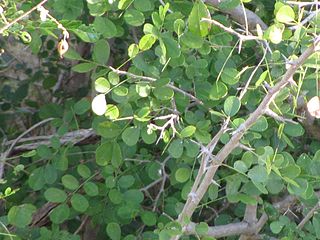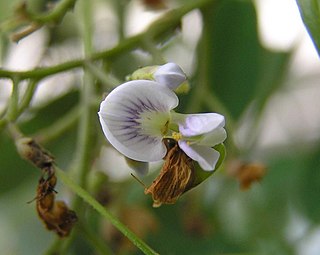
Dalbergia melanoxylon in french Granadille d'Afrique is a flowering plant in the family Fabaceae, native to seasonally dry regions of Africa from Senegal east to Eritrea and south to the north-eastern parts of South Africa. The tree is an important timber species in its native areas; it is used in the manufacture of musical instruments and fine furniture. Populations and genomic resources for genetic biodiversity maintenance in parts of its native range are threatened by overharvesting due to poor or absent conservation planning and by the species' low germination rates.

Dalbergia balansae also known as Dalbergia assamica is a species of legume in the family Fabaceae. It is found in China and Vietnam. It is threatened by habitat loss.
Dalbergia baronii is a species of flowering plant in the legume family Fabaceae. It is endemic to Madagascar. It is named after the English missionary and botanist Rev. Richard Baron.
Dalbergia bojeri is a species of legume in the family Fabaceae. It is found only in Madagascar. It is threatened by habitat loss.

Dalbergia boniana is a species of legume in the family Fabaceae. It is found only in Vietnam.
Dalbergia delphinensis is a species of legume in the family Fabaceae. It is found only in Madagascar. It is threatened by habitat loss.
Dalbergia entadoides is a species of liana, found in Cambodia, Laos, Thailand and Vietnam: with the Vietnamese name trắc bàm. The genus Dalbergia is placed in the subfamily Faboideae and tribe Dalbergieae; no subspecies are listed in the Catalogue of Life.
Dalbergia funera is a species of legume in the family Fabaceae. It is found in El Salvador and Guatemala. It is threatened by habitat loss.
Dalbergia louvelii is a species of legume in the family Fabaceae. It is found only in Madagascar. It is threatened by habitat loss.
Dalbergia maritima is a species of legume in the family Fabaceae; it is a rosewood, and its wood is often referred to as Bois de Rose. It is found only in Madagascar. It is threatened by habitat loss due to the over-consumption of its species.
Dalbergia monticola is a species of flowering plant in the legume family Fabaceae. It is endemic to Madagascar. It occurs at higher elevation, which gave the species its name.
Dalbergia normandii is a species of legume in the family Fabaceae. It is found only in Madagascar. It is threatened by habitat loss.

Dalbergia odorifera, fragrant rosewood or Chinese rosewood, is a species of legume in the family Fabaceae. It is a small or medium-sized tree, 10–15 metres (33–49 ft) tall. It is endemic to China and occurs in Fujian, Hainan, Zhejiang, and Guangdong.

Dalbergia oliveri is a species of legume in the family Fabaceae which grows in tree form to 15 – 30 meters in height. The fruit is a green pod containing one to two seeds which turn brown to black when ripe. It is threatened by habitat loss and over-harvesting for its valuable red "rosewood" timber.
Dalbergia orientalis is a species of legume in the family Fabaceae. It is found only in Madagascar.
Dalbergia pseudobaronii is a species of flowering plant in the legume family Fabaceae. It is endemic to Madagascar. Its leaves are similar to those of Dalbergia baronii, which gave the species its name.
Dalbergia simpsonii is a species of legume in the family Fabaceae. It is found only in Peru.
Dalbergia tsaratananensis is a species of legume in the family Fabaceae. It is found only in Madagascar. It is threatened by habitat loss.
Dalbergia urschii is a species of legume in the family Fabaceae. It is found only in Madagascar.

Dalbergia retusa is a plant species in the genus Dalbergia found in Pacific regions of Central America, ranging from Panama to southwestern Mexico. It produces the cocobolo wood. It is a fair-sized tree, reported to reach 20–25 m in height. This is probably the species contributing most of the wood in the trade. Because of the wood's great beauty and high value, the trees yielding this wood have been heavily exploited and are now rare outside national parks, reserves, and plantations.
This page is based on this
Wikipedia article Text is available under the
CC BY-SA 4.0 license; additional terms may apply.
Images, videos and audio are available under their respective licenses.






